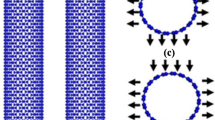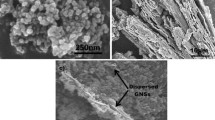Abstract
Recently, Shang et al. (Angew Chem Int Ed 57(3):774–778, 2018) have developed a method to synthesize ultrathin (around 1.9 nm) graphyne nanosheets. We reported here the mixed-mode I–II fracture toughnesses and crack growth angles of single-layer graphyne sheets using molecular dynamics (MD) simulations and the finite element (FE) method based on the boundary layer model, respectively. The various carbon–carbon bonds of graphyne sheets in the FE method are equated with the nonlinear Timoshenko beams based on the Tersoff–Brenner potential, where all the parameters of the nonlinear beams are completely determined based on the continuum modeling. All the results from the present FE method are reasonable in comparison with those from our MD simulations using the REBO potential. The present results show that both the critical stress intensity factors (SIFs) and the crack growth angle strongly depend on the chirality and loading angle \(\varphi \) (\(\varphi =90^{\circ }\) and \(\varphi =0^{\circ }\) representing pure mode I and pure mode II, respectively). Meanwhile, the fracture properties of single-layer cyclicgraphene and supergraphene sheets are also studied in order to compare with those of the graphyne sheets. The critical equivalent SIFs are derived as \(1.55<K_{{\text {eq-cy}}}\) (cyclic) \(<1.95\) nN Å\(^{-3/2}\), \(1.64<K_{{\text {eq-gy}}}\) (graphyne) \(<2.64\) nN Å\(^{-3/2}\) and \(0.61<K_{{\text {eq-su}}}\) (super)\(<2.04\) nN Å\(^{-3/2}\) in the corresponding zigzag and armchair sheets using the MD simulations, while the SIFs are \(0.32<K_{{\text {eq-cy}}}\) (cyclic) \(<0.48\) nN Å\(^{-3/2}\), \(1.96<K_{{\text {eq-gy}}}\) (graphyne) \(<2.49\) nN Å\(^{-3/2}\) and \(1.42<K_{{\text {eq-su}}}\) (super) \(<2.95\) nN Å\(^{-3/2}\) using the FE method. These findings should be of great help for understanding the fracture properties of carbon allotropes and designing the carbon-based nanodevices.





















Similar content being viewed by others
References
Hirsch A. The era of carbon allotropes. Nat Mater. 2010;9(11):868–71.
Diederich F, Rubin Y. Synthetic approaches toward molecular and polymeric carbon allotropes. Cheminform. 1992;31(9):1101–23.
Cranford SW, Buehler MJ. Mechanical properties of graphyne. Carbon. 2011;49(13):4111–21.
Li Y, Xu L, Liu H, Li Y. ChemInform abstract: graphdiyne and graphyne: from theoretical predictions to practical construction. Chem Soc Rev. 2014;43(8):2572–86.
Irifune T, Kurio A, Sakamoto S, et al. Materials: ultrahard polycrystalline diamond from graphite. Nature. 2003;421(6923):599–600.
Thompson BC, Frechet JMJ. Polymer-fullerene composite solar cells. Angew Chem Int Ed. 2008;47(1):58–77.
Baughman RH, Zakhidov AA, de Heer WA. Carbon nanotubes—the route toward applications. Science. 2002;297(5582):787–92.
Iijima S, Ichihashi T. Single-shell carbon nanotubes of 1-nm diameter. Nature. 1993;363(6430):603–5.
Li C, Chou TW. Elastic properties of single-walled carbon nanotubes in transverse directions. Phys Rev B Condens Matter. 2004;69(7):428–33.
Allen MJ, Tung VC, Kaner RB. Honeycomb carbon: a review of graphene. Chem Rev. 2010;110(1):132.
Zhang Z, Guo W. Energy-gap modulation of BN ribbons by transverse electric fields: first-principles calculations. Phys Rev B Condens Matter. 2008;77(7):439–46.
Li C, Chou TW. A structural mechanics approach for the analysis of carbon nanotubes. Int J Solids Struct. 2003;40(10):2487–99.
Chang T, Gao H. Size-dependent elastic properties of a single-walled carbon nanotube via a molecular mechanics model. J Mech Phys Solids. 2003;51(6):1059–74.
Zhao J, Wei N, Fan Z, Rabczuk T. The mechanical properties of three types of carbon allotropes. Nanotechnology. 2013;24(9):095702.
Li G, Li Y, Liu H, Guo Y, Li Y, Zhu D. Architecture of graphdiyne nanoscale films. Chem Commun. 2010;46(19):3256–8.
Shang H, Zuo Z, Li L, Wang F, Liu H, Li Y, Li Y. Ultrathin graphdiyne nanosheets grown in situ on copper nanowires and their performance as lithium-ion battery anodes. Angew Chem Int Ed. 2018;57(3):774–8.
Williams ML. On the stress distribution at the base of a stationary crack. J Appl Mech. 1957;24:109–14.
Authier A. International tables for crystallography: Volume D: Physical properties of crystals. 2nd ed. Wiley; 2014. p. 1245–54.
Enyashin AN, Ivanovskii AL. Graphene allotropes: stability, structural and electronic properties from DF–TB calculations. Phys Status Solidi. 2011;248:1879–83.
Heimann RB, Evsvukov SE, Koga Y. Carbon allotropes: a suggested classification scheme based on valence orbital hybridization. Carbon. 1997;35(10–11):1654–8.
Plimpton S. Fast parallel algorithms for short-range molecular dynamics. J Comput Phys. 1995;117(1):1–19.
Zhang B, Xiao H, Yang G, et al. Finite element modelling of the instability in rapid fracture of graphene. Eng Fract Mech. 2015;141:111–9.
Tabarraei A, Wang X, Jia D. Effects of hydrogen adsorption on the fracture properties of graphene. Comput Mater Sci. 2016;121:151–8.
Belytschko T, Xiao SP, Schatz GC, et al. Atomistic simulations of nanotube fracture. Phys Rev B Condens Matter. 2002;65(23):121.
Grantab R, Shenoy VB, Ruoff RS. Anomalous strength characteristics of tilt grain boundaries in graphene. Science. 2010;330(6006):946–8.
Gao H, Ji B, Jager IL, et al. Materials become insensitive to flaws at nanoscale: lessons from nature. Proc Natl Acad Sci USA. 2003;100(10):5597–600.
Lee C, Wei X, Kysar JW, et al. Measurement of the elastic properties and intrinsic strength of monolayer graphene. Science. 2008;321(5887):385–8.
Nosé S. A unified formulation of the constant temperature molecular dynamics methods. J Chem Phys. 1984;81(1):511–9.
Hoover WG. Canonical dynamics: equilibrium phase-space distributions. Phys Rev A Gen Phys. 1985;31(3):1695–7.
Abaqus GUI. Abaqus 6.11[J]. Users Manual 6.11, 2011.
Scarpa F, Adhikari S, Srikantha PA. Effective elastic mechanical properties of single layer graphene sheets. Nanotechnology. 2009;20(6):065709.
Brenner DW. Empirical potential for hydrocarbons for use in simulating the chemical vapor deposition of diamond films. Phys Rev B Condens Matter. 1990;42(15):9458–71.
Zhang B, Yang G, Xu H. Instability of supersonic crack in graphene. Phys B Phys Condens Matter. 2014;434(1):145–8.
Brenner DW, Shenderova OA, Harrison J, et al. A second-generation reactive empirical bond order (REBO) potential energy expression for hydrocarbons. J Phys Condens Matter. 2002;14(4):783–802.
Huang Y, Wu J, Hwang KC. Thickness of graphene and single-wall carbon nanotubes. Phys Rev B. 2006;74(24):4070–9.
Jiang Z, Lin R, Yu P, et al. The chirality-dependent fracture properties of single-layer graphene sheets: molecular dynamics simulations and finite element method. J Appl Phys. 2017;122(2):1421–32.
Zhang B, Mei L, Xiao HF. Nanofracture in graphene under complex mechanical stresses. Appl Phys Lett. 2012;101(12):121915.
Xu M, Tabarraei A, Paci JT, et al. A coupled quantum/continuum mechanics study of graphene fracture. Int J Fract. 2012;173(2):163–73.
Zhang S, Zhu T, Belytschko T. Atomistic and multiscale analyses of brittle fracture in crystal lattices. Phys Rev B Condens Matter. 2007;76(9):094114.
Hou J, Yin Z, Zhang Y, Chang TC. Structure dependent elastic properties of supergraphene. Acta Mech Sin. 2016;32:684–9.
Yin H, Qi HJ, Fan F, Zhu T, Wang B, Wei Y. Griffith criterion for brittle fracture in graphene. Nano Lett. 2015;15:1918–24.
Wei Y, Yang R. Nanomechanics of graphene. Natl Sci Rev. 2018;0:1–25.
Acknowledgements
We gratefully acknowledge supports from the National Natural Science Foundation of China (Grant Nos. 11572140 and 11602096), the Natural Science Foundation of Jiangsu Province (Grant No. BK20180031, BK20160158), the National First-Class Discipline Program of Food Science and Technology (Grant No. JUFSTR20180205), the 111 Project (Grant No. B18027), the Programs of Innovation and Entrepreneurship of Jiangsu Province, Primary Research and Development Plan of Jiangsu Province (Grant No. BE2017069), Science and Technology Plan Project of Wuxi, the Fundamental Research Funds for the Central Universities (Grant Nos. JUSRP11529 and JG2015059), Postgraduate Research and Practice Innovation Program of Jiangsu Province (Grant No. KYCX17_1473), Research Project of State Key Laboratory of Mechanical System and Vibration (MSV201909), the Project of Jiangsu Provincial Six Talent Peaks in Jiangsu Province and the Thousand Youth Talents Plan.
Author information
Authors and Affiliations
Corresponding author
Rights and permissions
About this article
Cite this article
Jiang, Z., Lin, R. & Zhao, J. Fracture Toughnesses and Crack Growth Angles of Single-Layer Graphyne Sheets. Acta Mech. Solida Sin. 32, 339–355 (2019). https://doi.org/10.1007/s10338-019-00086-7
Received:
Revised:
Accepted:
Published:
Issue Date:
DOI: https://doi.org/10.1007/s10338-019-00086-7




